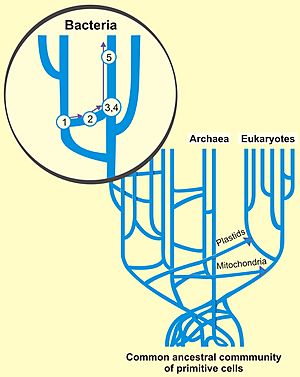Horizontal gene transfer facts for kids
Horizontal gene transfer (HGT) is a cool way that living things can share genetic material. Imagine it like sharing a secret recipe with a friend, not just passing it down from your parents. This means an organism gets DNA or RNA from another organism that isn't its parent or ancestor.
This is different from vertical transfer, which is how you get your genes from your parents. Most of what we know about genetics focuses on vertical transfer. However, scientists are now realizing that HGT is super important, especially for tiny, single-celled organisms like bacteria. Sometimes, HGT is even used by scientists in genetic engineering to give new traits to organisms.
Contents
What is Horizontal Gene Transfer?
Horizontal gene transfer (HGT) is when an organism gets genetic information from another organism that is not its direct ancestor. Think of it as a side-to-side transfer of genes, rather than a top-down transfer from parents to children.
Vertical vs. Horizontal Gene Transfer
- Vertical transfer is the usual way genes are passed down. This happens when an organism inherits genetic material from its parents or previous generations. It's like a family tree where traits go from one generation to the next.
- Horizontal transfer is different. It's when genes jump between organisms that are not related by parent-child relationships. This can happen between different types of bacteria or even between different species.
How Does HGT Happen?
There are several ways that horizontal gene transfer can take place. These methods allow genetic material to move between organisms.
Transformation
- Transformation is when a cell takes in free genetic material (like DNA or RNA) from its surroundings. This genetic material might have been released by another cell that died.
- Once inside, the cell can use this new genetic material. This process is common in bacteria. Scientists often use transformation in labs to add new genes to bacteria for experiments or to make useful things like medicines.
Transduction
- Transduction involves a special kind of virus called a bacteriophage (or 'phage'). These viruses infect bacteria.
- During infection, the phage can pick up pieces of bacterial DNA. When this phage then infects another bacterium, it can transfer that bacterial DNA to the new host.
Bacterial Conjugation
- Bacterial conjugation is like bacteria "mating" or directly sharing genetic material.
- One bacterial cell connects to another using a special tube-like structure. Through this tube, it can transfer a copy of its genetic material, often a small circular piece of DNA called a plasmid, to the other cell.
Gene Transfer Agents (GTAs)
- A gene transfer agent (GTA) is like a tiny, virus-like package. It carries random bits of a host cell's chromosome.
- GTAs are found in many types of bacteria. They are made by the host cell itself. These agents transfer DNA so often that they might play a big role in how life evolves.
- For example, in 2010, scientists found that GTAs could be engineered in the lab to transfer genes that make bacteria resistant to antibiotics.
Integrons
- Integrons are special DNA structures found in bacteria. They act like a "kit" for collecting and sharing genes.
- Integrons can capture and express small pieces of DNA called "gene cassettes." These cassettes often contain genes that help bacteria survive, like genes for antibiotic resistance.
History of HGT Discovery
Scientists first learned about horizontal gene transfer in Japan in 1959. They saw that bacteria could transfer antibiotic resistance to different species of bacteria. This was a big discovery!
In the mid-1980s, a scientist named Syvanen suggested that HGT was not just interesting, but that it had shaped the evolution of life on Earth from the very beginning.
Today, more and more studies show that HGT has been very important, especially for prokaryotes (like bacteria) and single-celled eukaryotes (like protists). Some evidence even suggests that HGT might affect higher plants and animals, though scientists are still studying how common and important it is in these more complex organisms.
See also
 In Spanish: Transferencia genética horizontal para niños
In Spanish: Transferencia genética horizontal para niños


